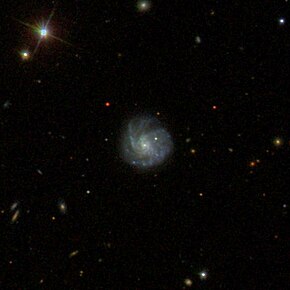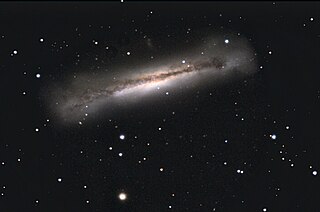
NGC 3628, also known as the Hamburger Galaxy or Sarah's Galaxy, is an unbarred spiral galaxy about 35 million light-years away in the constellation Leo. It was discovered by William Herschel in 1784. It has an approximately 300,000 light-years long tidal tail. Along with M65 and M66, NGC 3628 forms the Leo Triplet, a small group of galaxies. Its most conspicuous feature is the broad and obscuring band of dust located along the outer edge of its spiral arms, effectively transecting the galaxy to the view from Earth.

NGC 2 is an intermediate spiral galaxy with the morphological type of Sab, located in the constellation of Pegasus. NGC 2 was discovered by Lawrence Parsons, 4th Earl of Rosse on 20 August 1873."

NGC 3 is a lenticular galaxy with the morphological type of S0, located in the constellation of Pisces. Other sources classify NGC 3 as a barred spiral galaxy as a type of SBa. It was discovered on November 29, 1864, by Albert Marth.

NGC 6744 is an intermediate spiral galaxy about 30 million light-years away in the constellation Pavo (Peacock). It is considered as a Milky Way mimic in the immediate vicinity, displaying flocculent (fluffy) arms and an elongated core. It also has at least one distorted companion galaxy superficially similar to one of the Magellanic Clouds. It was discovered from Parramatta in Australia by Scottish astronomer James Dunlop on 30 June 1826.

NGC 480 is a spiral galaxy located about 546 million light-years away from Earth in the constellation Cetus. NGC 480 was discovered by American astronomer Francis Leavenworth In 1886.

NGC 3506 is a spiral galaxy in the constellation Leo. It is located at a distance of circa 300 million light years from Earth, which, given its apparent dimensions, means that NGC 3506 is about 115,000 light years across. The galaxy has two main spiral arms, with high surface brightness, which can be traced for half a revolution before they fade. One arm splits into four spiral arcs.

NGC 4540 is a spiral galaxy with type 1 Seyfert activity located about 64 million light-years away in the constellation Coma Berenices. NGC 4540 was discovered by astronomer William Herschel on March 21, 1784 and is a member of the Virgo Cluster.

NGC 6040 is a spiral galaxy located about 550 million light-years away in the constellation Hercules. NGC 6040 was discovered by astronomer Édouard Stephan on June 27, 1870. NGC 6040 is interacting with the lenticular galaxy PGC 56942. As a result of this interaction, NGC 6040's southern spiral arm has been warped in the direction toward PGC 56942. NGC 6040 and PGC 56942 are both members of the Hercules Cluster.

NGC 521, also occasionally referred to as PGC 5190 or UGC 962, is a barred spiral galaxy located approximately 224 million light-years from the Solar System in the constellation Cetus. It was discovered on 8 October 1785 by astronomer William Herschel.

NGC 3840 is a spiral galaxy located about 320 million light-years away in the constellation Leo. The galaxy was discovered by astronomer Heinrich d'Arrest on May 8, 1864. NGC 3840 is a member of the Leo Cluster. The galaxy is rich in neutral atomic hydrogen and is not interacting with its environment.

NGC 3860 is a spiral galaxy located about 340 million light-years away in the constellation Leo. NGC 3860 was discovered by astronomer William Herschel on April 27, 1785. The galaxy is a member of the Leo Cluster and is a low-luminosity AGN (LLAGN). Gavazzi et al. however classified NGC 3860 as a strong AGN which may have been triggered by a supermassive black hole in the center of the galaxy.

NGC 3864 is a spiral galaxy located about 330 million light-years away in the constellation Leo. The galaxy was discovered by astronomer Édouard Stephan on March 23, 1884. It is a member of the Leo Cluster.
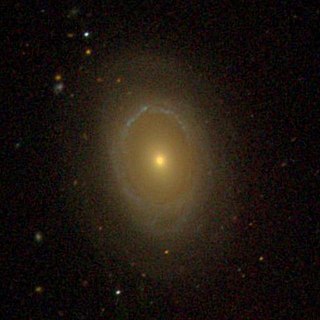
NGC 3884 is a spiral galaxy located about 330 million light-years away in the constellation Leo. The galaxy was discovered by astronomer William Herschel on April 27, 1785 and is a member of the Leo Cluster.
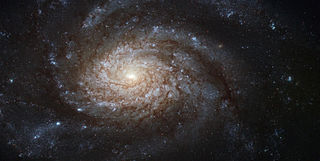
NGC 3810 is a spiral galaxy located in the constellation Leo. It is about 50 million light years from Earth, and estimated to be about 60,000 light years in diameter. William Herschel discovered it on 15 March 1784.

NGC 3664 is a magellanic barred spiral galaxy in the constellation of Leo. It is located about 80 million light years away from Earth, which means, given its apparent dimensions, that NGC 3664 is approximately 50,000 light years across. It was discovered by Wilhelm Tempel on March 14, 1879. It is a member of the NGC 3640 Group of galaxies, which is a member of the Leo II Groups, a series of galaxies and galaxy clusters strung out from the right edge of the Virgo Supercluster.
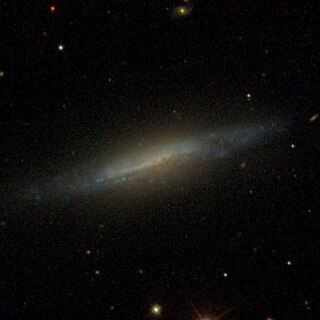
NGC 4359 is a dwarf barred spiral galaxy seen edge-on that is about 56 million light-years away in the constellation Coma Berenices. It was discovered by astronomer William Herschel on March 20, 1787. It is a member of the NGC 4274 Group, which is part of the Coma I Group or Cloud.

NGC 4393 is a spiral galaxy about 46 million light-years away in the constellation Coma Berenices. It was discovered by astronomer William Herschel on April 11, 1785. It is a member of the NGC 4274 Group, which is part of the Coma I Group or Cloud.

NGC 6622 is an interacting spiral galaxy in the constellation Draco. It is located around 313 million light-years away, and it was discovered by Edward D. Swift and Lewis A. Swift on June 2, 1885. NGC 6622 interacts with NGC 6621, with their closest approach having taken place about 100 million years before the moment seen now. NGC 6622 and NGC 6621 are included in the Atlas of Peculiar Galaxies as Arp 81 in the category "spiral galaxies with large high surface brightness companions".

NGC 1616 is an intermediate spiral galaxy located around 213 million light-years away in the constellation Caelum. NGC 1616 was discovered on October 24th, 1835 by the astronomer John Herschel, and its diameter is 116,000 light-years across. NGC 1616 is not know to have much star-formation, and it is not known to have an active galactic nucleus.

NGC 4825 is a lenticular galaxy located around 230 million light-years away in the constellation Virgo. NGC 4825 was discovered on March 27th, 1786 by the astronomer William Herschel, and its diameter is 133,000 light-years across. NGC 4825 is not know to have much star-formation, and it does not have an active galactic nucleus.
